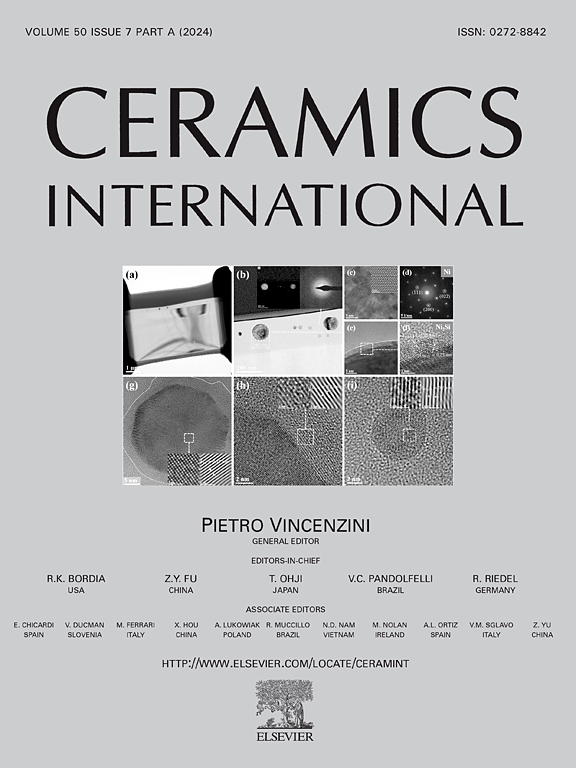Enhancing the energy storage performance of NBT-based ceramics through grain boundary design
IF 5.6
2区 材料科学
Q1 MATERIALS SCIENCE, CERAMICS
引用次数: 0
Abstract
The limited breakdown field strength of Na0.5Bi0.5TiO3 (NBT) ceramics is considered a major obstacle to achieving high energy storage performance. Herein, a grain boundary design strategy was demonstrated by introducing BN nanosheets (BNNs) at the grain boundaries of 0.79Na0.5Bi0.5TiO3-0.21NaNbO3 (NBT-NN) ceramics to enhance the breakdown field strength and improve the energy storage performance. The effects of BNNs contents on the phase composition, microstructure, dielectric properties, and energy storage performance of NBT-NN ceramics were investigated. It was found that the BNNs dispersed along the grain boundaries of NBT–NN, significantly enhanced grain boundary resistance due to their excellent insulating properties, thereby substantially improving the breakdown field strength (Eb). In the NBT-NN-0.1 wt% BNNs composite ceramics, the breakdown field strength (280 kV/cm) increased by 21.7 %, and the recoverable energy storage density (Wrec = 5.67 J/cm3) improved by 41.4 %. The dielectric spectroscopy and impedance analysis were employed to investigate the dynamic evolution of the dominant resistive phase and the overall resistivity of the NBT-based ceramics. The addition of an appropriate amount of BNNs significantly enhanced the grain boundary resistance of NBT-NN ceramics, resulting in higher breakdown field strength and energy storage performance. This study shows that the design approach of introducing BNNs at the grain boundaries to enhance the breakdown field strength offers a novel perspective for improving the energy storage performance of NBT-based ceramics.
通过晶界设计提高nbt基陶瓷的储能性能
Na0.5Bi0.5TiO3 (NBT)陶瓷有限的击穿场强被认为是实现高储能性能的主要障碍。本文提出了一种晶界设计策略,即在0.79Na0.5Bi0.5TiO3-0.21NaNbO3 (NBT-NN)陶瓷的晶界处引入BN纳米片(BNNs),以增强击穿场强,提高储能性能。研究了BNNs含量对NBT-NN陶瓷的相组成、微观结构、介电性能和储能性能的影响。结果发现,bnn沿NBT-NN晶界分散,由于其优异的绝缘性能,显著提高了晶界电阻,从而大幅提高了击穿场强(Eb)。在NBT-NN-0.1 wt% BNNs复合陶瓷中,击穿场强(280 kV/cm)提高了21.7%,可回收储能密度(Wrec = 5.67 J/cm3)提高了41.4%。采用介电光谱和阻抗分析方法研究了nbt基陶瓷的优势电阻相和总电阻率的动态演变。适量的BNNs的加入显著提高了NBT-NN陶瓷的晶界电阻,击穿场强和储能性能提高。研究表明,在晶界处引入BNNs增强击穿场强的设计方法为提高nbt基陶瓷的储能性能提供了新的思路。
本文章由计算机程序翻译,如有差异,请以英文原文为准。
求助全文
约1分钟内获得全文
求助全文
来源期刊

Ceramics International
工程技术-材料科学:硅酸盐
CiteScore
9.40
自引率
15.40%
发文量
4558
审稿时长
25 days
期刊介绍:
Ceramics International covers the science of advanced ceramic materials. The journal encourages contributions that demonstrate how an understanding of the basic chemical and physical phenomena may direct materials design and stimulate ideas for new or improved processing techniques, in order to obtain materials with desired structural features and properties.
Ceramics International covers oxide and non-oxide ceramics, functional glasses, glass ceramics, amorphous inorganic non-metallic materials (and their combinations with metal and organic materials), in the form of particulates, dense or porous bodies, thin/thick films and laminated, graded and composite structures. Process related topics such as ceramic-ceramic joints or joining ceramics with dissimilar materials, as well as surface finishing and conditioning are also covered. Besides traditional processing techniques, manufacturing routes of interest include innovative procedures benefiting from externally applied stresses, electromagnetic fields and energetic beams, as well as top-down and self-assembly nanotechnology approaches. In addition, the journal welcomes submissions on bio-inspired and bio-enabled materials designs, experimentally validated multi scale modelling and simulation for materials design, and the use of the most advanced chemical and physical characterization techniques of structure, properties and behaviour.
Technologically relevant low-dimensional systems are a particular focus of Ceramics International. These include 0, 1 and 2-D nanomaterials (also covering CNTs, graphene and related materials, and diamond-like carbons), their nanocomposites, as well as nano-hybrids and hierarchical multifunctional nanostructures that might integrate molecular, biological and electronic components.
 求助内容:
求助内容: 应助结果提醒方式:
应助结果提醒方式:


